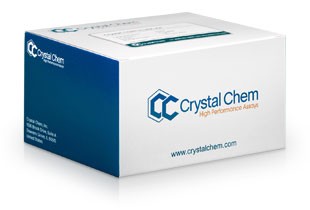Rat Total Bile Acids Assay Kit
Product Specifications
| Catalog # | 80460 |
| Sample Size | 20 µL |
| Sample Types | Serum, Plasma (customer protocols for bile acid in rat liver tissue, feces, and other applications available upon request) |
| Tests | 96 |
| Reagents | Liquid/Powder |
| Assay Range | 0 - 180 µmol/L |
| Assay Time | < 15 mins |
| Precision | CV: < 10% |
| Regulatory | Research Use Only |
| Distribution | Worldwide |
| Assay Summary |
 Assay and protocol summary
Assay and protocol summary |
Additional Info
This kit has been discontinued and replaced by an UPDATED VERSION. The new kit:
- Uses less sample
- Contains all liquid reagents
- Uses materials that have a longer stability after opening
- Uses a procedure that offers more stable results
Bile acids are an important test for monitoring normal liver function. Bile acid is metabolized in the liver and is present in increased concentrations with abnormal liver function. This assay can be used to measure bile acid concentrations in rat in a wide variety of applications including rat serum, liver, bile, feces, and intestine.
Optional products to use with this kit:
References
| Reiling, J., et al. Biochimica et Biophysica Acta (BBA) - Molecular Basis of Disease 2017: in press. Read more |
| Reiling, Janske, et al. Liver Transplantation 2017; 23: 184-206. Read more |
| Zhang, Linda S., et al. American Journal of Physiology-Gastrointestinal and Liver Physiology 2015; 309: G918-925. Read more |
| Zhou, Hui, et al. American Journal of Physiology-Gastrointestinal and Liver Physiology 2015; 308: G863-G873. Read more |
| Ghoneim, Ragia H., et al. " British Journal of Nutrition 2015; 113: 507-516. Read more |
| Zinkhan, Erin K., et al. Pediatric Research 2014; 76: 432-440. Read more |

 Australia
Australia
 Austria
Austria
 Bangladesh
Bangladesh
 Belgium
Belgium
 Brazil
Brazil
 Canada
Canada
 China
China
 Denmark
Denmark
 Finland
Finland
 France
France
 Germany
Germany
 Greece
Greece
 Hong Kong
Hong Kong
 India
India
 Ireland
Ireland
 Israel
Israel
 Italy
Italy
 Japan
Japan
 Malaysia
Malaysia
 Mexico
Mexico
 Netherlands
Netherlands
 New Zealand
New Zealand
 Norway
Norway
 Pakistan
Pakistan
 Singapore
Singapore
 South Korea
South Korea
 Spain
Spain
 Sweden
Sweden
 Switzerland
Switzerland
 Taiwan
Taiwan
 United Kingdom
United Kingdom
 Control for Rat Total Bile Acids Assay Kit
Control for Rat Total Bile Acids Assay Kit